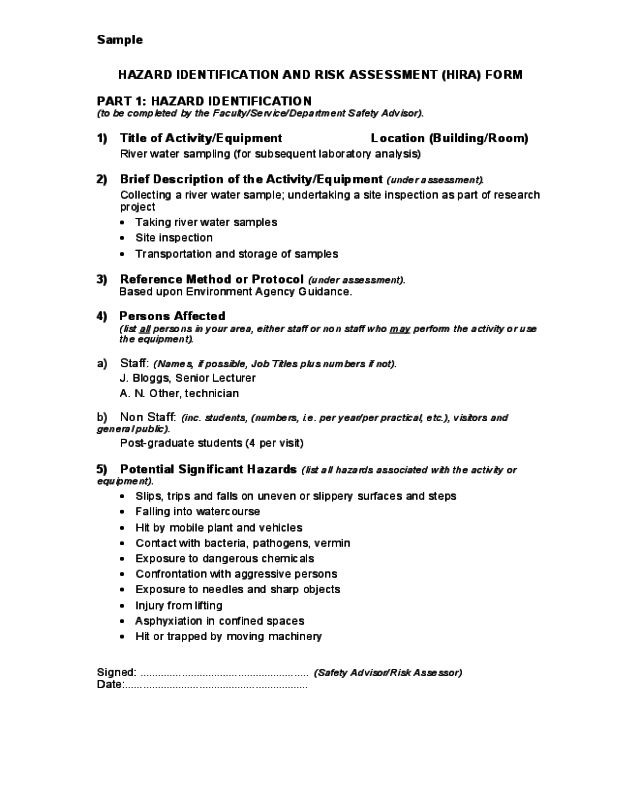Fillable Printable Hazard Identification and Risk Assessment Template
Fillable Printable Hazard Identification and Risk Assessment Template

Hazard Identification and Risk Assessment Template

Sample
HAZARD IDENTIFICATION AND RISK ASSESSMENT (HIRA) FORM
PART 1: HAZARD IDENTIFICATION
(to be completed by the Faculty/Service/Department Safety Advisor).
1) Title of Activity/Equipment Location (Building/Room)
River water sampling (for subsequent laboratory analysis)
2) Brief Description of the Activity/Equipment
(under assessment).
Collecting a river water sample; undertaking a site inspection as part of research
project
Taking river water samples
Site inspection
Transportation and storage of samples
3) Reference Method or Protocol (under assessment).
Based upon Environment Agency Guidance.
4) Persons Affected
(list all persons in your area, either staff or non staff who may perform the activity or use
the equipment).
a) Staff:
(Names, if possible, Job Titles plus numbers if not).
J. Bloggs, Senior Lecturer
A. N. Other, technician
b) Non Staff: (inc. students, (numbers, i.e. per year/per practical, etc.), visitors and
general public).
Post-graduate students (4 per visit)
5) Potential Significant Hazards
(list all hazards associated with the activity or
equipment).
Slips, trips and falls on uneven or slippery surfaces and steps
Falling into watercourse
Hit by mobile plant and vehicles
Contact with bacteria, pathogens, vermin
Exposure to dangerous chemicals
Confrontation with aggressive persons
Exposure to needles and sharp objects
Injury from lifting
Asphyxiation in confined spaces
Hit or trapped by moving machinery
Signed:
.........................................................
(Safety Advisor/Risk Assessor)
Date:..............................................................

Sample
PART 2: RISK ASSESSMENT
(to be completed by appropriate person)
Risk = likelihood (of event occurring) x hazard (severity)
Using the definition of Risk which covers both likelihood (chance) of
occurrence and severity of harm (taking into account population at risk and
level of injury possible) calculate the risk by grading the likelihood (1-4) and
the severity (1-4), (1=Low, 4=High), giving a final figure between 1 and 16.
Hazard Identified
(see list in Part 1, Section 5)
Likelihood of
occurrence
(grade 1-4)
(A)
Hazard
(Severity)
(grade 1-4)
(B)
Risk
(likelihood x
Hazard)
(A x B)
Slips, trips and falls on
uneven or slippery
surfaces and steps
Falling into watercourse
Hit by mobile plant and
vehicles
Contact with bacteria,
pathogens, vermin
Exposure to dangerous
chemicals
Confrontation with
aggressive persons
Exposure to needles and
sharp objects
Injury from lifting
Asphyxiation in confined
spaces
Hit or trapped by moving
machinery
2
2
1
3
2
1
1
2
1
1
2
3
3
3
3
2
3
2
3
3
4
6
3
9
6
2
3
4
3
3
Signed: .........................................................................
Dean/Head of
School/Service/Supervisor
Date: ..............................................

Sample
PART 3. CONTROL MEASURES
a) EXISTING (list all controls that are existing in place)
Slips, trips and falls on uneven or slippery surfaces
and steps
Wear safety footwear. Do not climb
steep surfaces whilst carrying
equipment. Be aware of risk of
surveying close to watercourses.
Hit by mobile plant and vehicles
Wear high visibility clothing. Keep to
marked footpaths where possible. If
a survey location is close to a road,
extra care must be taken.
Adverse weather conditions
Wear appropriate clothing. Ensure
that surveys are only conducted in
favourable weather conditions.
Ensure provision of waterproof
clothing if required.
Confrontation with aggressive persons/animals
Avoid confrontational situations and
adopt a non-confrontation manner.
Wherever possible, and particularly
in certain areas, ensure that surveys
are carried out in pairs.
Getting lost in an unfamiliar area
Make a preliminary site visit with a
person who knows the area or with a
map.
General control measures
Observe written and oral guidance
provided by staff. Inform a
nominated, reliable person where
and when survey is taking place and
over what time period. Carry
identification and a mobile telephone
(or have ready access to a public
telephone).
Existing Controls Satisfactory? YES
(if NO parts b) and c) must be completed)
b) SHORT TERM REQUIREMENTS
(implementation within six months)
IMPLEMENTATION
DATE
COMPLETION
DATE
Ensure all persons involved read risk assessment.
Before visiting site
Ensure all persons involved have received some
guidance on surveying.
Before visiting site
Check all persons involved in survey have
appropriate clothing and personal protective
equipment (PPE).
Before visiting site
and at site
c) LONG TERM REQUIREMENTS
(implementation within six to eighteen months)
IMPLEMENTATION
DATE
COMPLETION
DATE
Signed as Completed: ............................................................ Dean/HOS/HOD Date: ...............................
Comments: Original to be kept by Faculty/Department/Service
Assessment review date: Annual

Sample
PART 4. NOTIFICATION OF CHANGES
(To be completed by Line Manager and Risk Assessor)
Any significant change to the working activity or equipment must be suitably
assessed.
1) Description of Changes to Activity/Equipment
(Brief details only)
None at present
2) New Potential Hazards Associated with Changed Activity/Equipment
N/A
3) Control Measures to be Implemented
No new measures required
Signed: .............................................................................
Dean/HOS/HOD
Date: ............................



